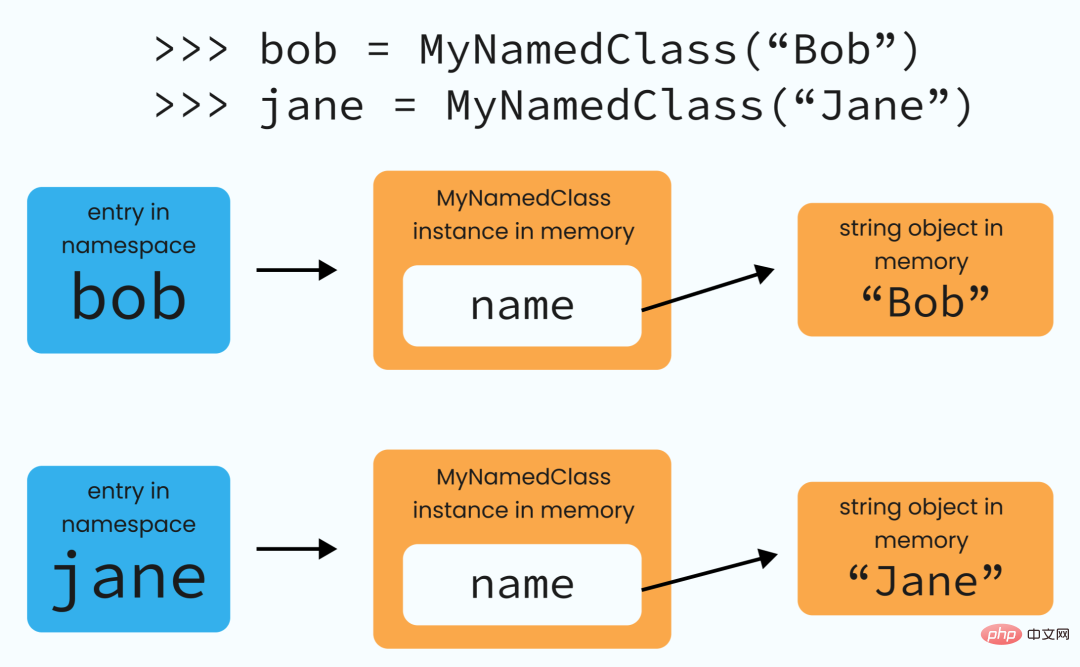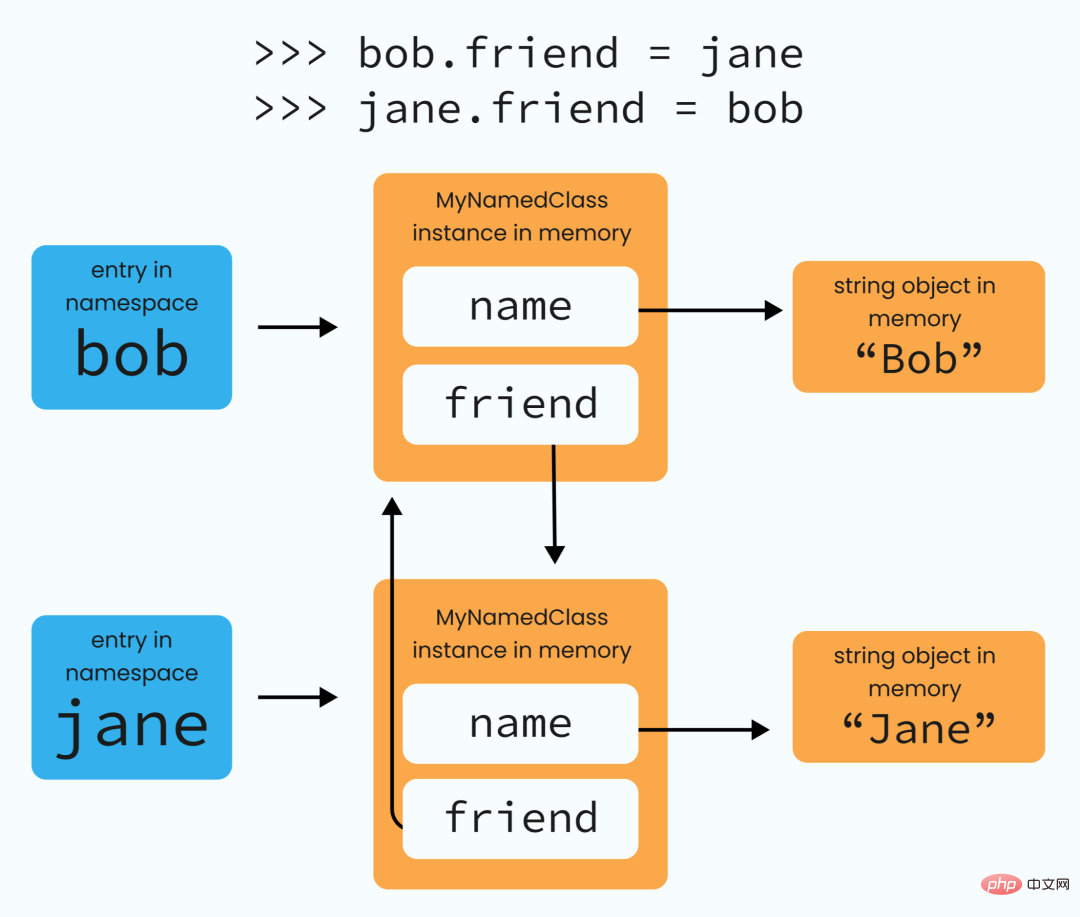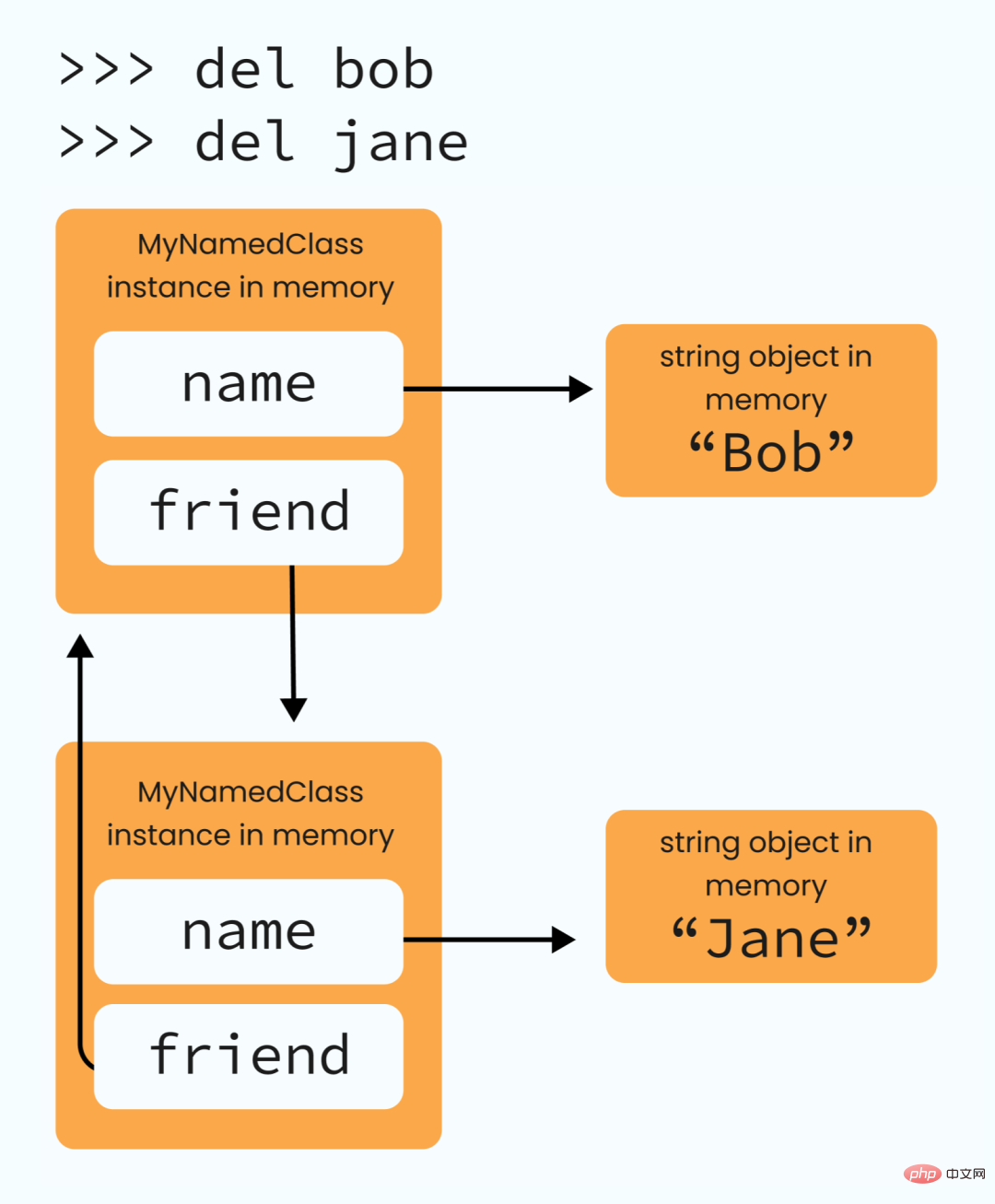Reference counting in Python garbage collection mechanism
The __del__ magic method in Python, also known as the object's terminator, is a method that is called just before the object is about to be removed from memory. It doesn't actually do the job of removing the object from memory, we'll see how that happens later. Instead, this method is used to do any cleanup that needs to occur before the object is removed. For example, close any files that were open when the object was created.
In this section, we will use the following class as an example.
class MyNameClass:
def __init__(self, name):
self.name = name
def __del__(self):
print(f"Deleting {self.name}!")In the above example, we have defined our class to accept a name as input when initialized, and when the finaliser is called, it will let us know by printing the name of the relevant instance. This way, we can learn which objects were deleted from memory and when.
So, when does CPython decide to delete an object from memory? There are two ways (as of CPython 3.10) that this can happen: reference counting and garbage collection.
Reference Counting
If we have a pointer to an object in Python, it is a reference to the object. For a given object a , CPython keeps track of how many other things point to a . If this counter reaches zero, it is safe to remove the object from memory since nothing else is using it. Let's look at an example.
>>> Harward = MyNameClass("Harward")
>>> del Harward
Deleting Harward!
>>>Here, we create a new object (MyNamedClass("Harward")) and create a pointer to it (Harward =). Then, when we delete Harwade, we delete this reference and the MyNamedClass instance now has a reference count of 0. So, CPython decides to delete it from memory - and, just before doing so, its __del__ method is called, printing the message we saw above.
If we create multiple references to an object, we will have to get rid of all references in order for the object to be deleted.
>>> bob = MyNameClass("Bob")
>>> bob_two = bob # creating a new pointer to the same object
>>> del bob # this doesn't cause the object to be removed...
>>> del bob_two # ... but this does
Deleting Bob!Of course, our MyNamedClass instances can themselves contain pointers - they are arbitrary Python objects after all, and we can add any properties we like to them. Let's look at an example.
>>> jane = MyNamedClass("Jane")
>>> bob = MyNamedClass("Bob")
>>> jane.friend = bob # now the "Jane" object contains a pointer to the "Bob" object...
>>> bob.friend = janeWhat we did in the above code snippet is set up some circular references. An object named Jane contains a pointer to an object named Bob, and vice versa. Things get interesting when we do the following.
>>> del jane >>> del bob
We have now removed the pointer from the namespace to the object. Now, we have no access to those MyNameClass objects at all -- but we don't get a print message telling us that they are about to be deleted. This is because these objects still have references, contained within each other, so their reference counts are not 0 .
What we create here is a loop isolate; in this structure, each object has at least one reference in the loop, keeping it alive, but all objects in the loop cannot be removed from the namespace was visited.
Intuitive performance of loop isolation
The following is the intuitive performance when we create a loop isolation.
First, we create two objects, each object has a name in the namespace.

Next, we connect our two objects by adding a pointer to each object.

#Finally, we remove the pointers from the namespace by removing the original names of both objects. At this point, the two objects are not accessible from the namespace, but each object contains a pointer to the other object, so their reference counts are not zero.

So, it is obvious that reference counting alone is not enough to keep the runtime working memory free of useless, non-recyclable objects. This is where CPython's garbage collector comes into play.
The above is the detailed content of Reference counting in Python garbage collection mechanism. For more information, please follow other related articles on the PHP Chinese website!

Hot AI Tools

Undresser.AI Undress
AI-powered app for creating realistic nude photos

AI Clothes Remover
Online AI tool for removing clothes from photos.

Undress AI Tool
Undress images for free

Clothoff.io
AI clothes remover

Video Face Swap
Swap faces in any video effortlessly with our completely free AI face swap tool!

Hot Article

Hot Tools

Notepad++7.3.1
Easy-to-use and free code editor

SublimeText3 Chinese version
Chinese version, very easy to use

Zend Studio 13.0.1
Powerful PHP integrated development environment

Dreamweaver CS6
Visual web development tools

SublimeText3 Mac version
God-level code editing software (SublimeText3)

Hot Topics
 1386
1386
 52
52
 Can visual studio code be used in python
Apr 15, 2025 pm 08:18 PM
Can visual studio code be used in python
Apr 15, 2025 pm 08:18 PM
VS Code can be used to write Python and provides many features that make it an ideal tool for developing Python applications. It allows users to: install Python extensions to get functions such as code completion, syntax highlighting, and debugging. Use the debugger to track code step by step, find and fix errors. Integrate Git for version control. Use code formatting tools to maintain code consistency. Use the Linting tool to spot potential problems ahead of time.
 How to run programs in terminal vscode
Apr 15, 2025 pm 06:42 PM
How to run programs in terminal vscode
Apr 15, 2025 pm 06:42 PM
In VS Code, you can run the program in the terminal through the following steps: Prepare the code and open the integrated terminal to ensure that the code directory is consistent with the terminal working directory. Select the run command according to the programming language (such as Python's python your_file_name.py) to check whether it runs successfully and resolve errors. Use the debugger to improve debugging efficiency.
 Can vs code run in Windows 8
Apr 15, 2025 pm 07:24 PM
Can vs code run in Windows 8
Apr 15, 2025 pm 07:24 PM
VS Code can run on Windows 8, but the experience may not be great. First make sure the system has been updated to the latest patch, then download the VS Code installation package that matches the system architecture and install it as prompted. After installation, be aware that some extensions may be incompatible with Windows 8 and need to look for alternative extensions or use newer Windows systems in a virtual machine. Install the necessary extensions to check whether they work properly. Although VS Code is feasible on Windows 8, it is recommended to upgrade to a newer Windows system for a better development experience and security.
 Is the vscode extension malicious?
Apr 15, 2025 pm 07:57 PM
Is the vscode extension malicious?
Apr 15, 2025 pm 07:57 PM
VS Code extensions pose malicious risks, such as hiding malicious code, exploiting vulnerabilities, and masturbating as legitimate extensions. Methods to identify malicious extensions include: checking publishers, reading comments, checking code, and installing with caution. Security measures also include: security awareness, good habits, regular updates and antivirus software.
 Python: Automation, Scripting, and Task Management
Apr 16, 2025 am 12:14 AM
Python: Automation, Scripting, and Task Management
Apr 16, 2025 am 12:14 AM
Python excels in automation, scripting, and task management. 1) Automation: File backup is realized through standard libraries such as os and shutil. 2) Script writing: Use the psutil library to monitor system resources. 3) Task management: Use the schedule library to schedule tasks. Python's ease of use and rich library support makes it the preferred tool in these areas.
 What is vscode What is vscode for?
Apr 15, 2025 pm 06:45 PM
What is vscode What is vscode for?
Apr 15, 2025 pm 06:45 PM
VS Code is the full name Visual Studio Code, which is a free and open source cross-platform code editor and development environment developed by Microsoft. It supports a wide range of programming languages and provides syntax highlighting, code automatic completion, code snippets and smart prompts to improve development efficiency. Through a rich extension ecosystem, users can add extensions to specific needs and languages, such as debuggers, code formatting tools, and Git integrations. VS Code also includes an intuitive debugger that helps quickly find and resolve bugs in your code.
 Can vs code run python
Apr 15, 2025 pm 08:21 PM
Can vs code run python
Apr 15, 2025 pm 08:21 PM
Yes, VS Code can run Python code. To run Python efficiently in VS Code, complete the following steps: Install the Python interpreter and configure environment variables. Install the Python extension in VS Code. Run Python code in VS Code's terminal via the command line. Use VS Code's debugging capabilities and code formatting to improve development efficiency. Adopt good programming habits and use performance analysis tools to optimize code performance.
 Can visual studio code run python
Apr 15, 2025 pm 08:00 PM
Can visual studio code run python
Apr 15, 2025 pm 08:00 PM
VS Code not only can run Python, but also provides powerful functions, including: automatically identifying Python files after installing Python extensions, providing functions such as code completion, syntax highlighting, and debugging. Relying on the installed Python environment, extensions act as bridge connection editing and Python environment. The debugging functions include setting breakpoints, step-by-step debugging, viewing variable values, and improving debugging efficiency. The integrated terminal supports running complex commands such as unit testing and package management. Supports extended configuration and enhances features such as code formatting, analysis and version control.




